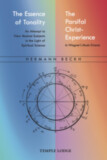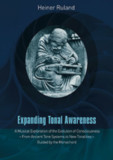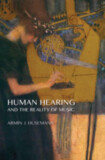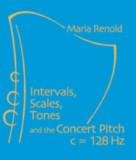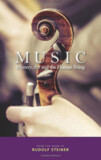The Inner Nature of Music
And the Experience of Tone (CW 283)
- Publisher
SteinerBooks - ISBN 9781621483465
- Language English
- Size 6" x 9.25"
7 lectures in various cities, December 3, 1906 – March 16, 1923 (CW 283)
"A tone is at the foundation of everything in the physical world."
This is one of many astonishing statements made by Rudolf Steiner in this collection of seven lectures on the inner realities of music. These lectures are an unusual treasure, since they are the only two groups of lectures that Steiner gave primarily on music, other than the lecture cycle for the tone eurythmy course, Eurythmy as Visible Music.
In the first group of three lectures, given in 1906, Steiner explains why music affects the human soul so powerfully. Music has always held a special position among the arts because it is the only art form whose archetype, or source, lies not in the physical world, as with architecture, sculpture, and painting, but purely in the spiritual world-the soul's true home. Music thus directly expresses through tones the innermost essence of the cosmos, and our sense of wellbeing when we hear music comes from a recognition of our soul's experience in the spiritual world.
In the remaining lectures, given in 1922 and 1923, Steiner discusses our experience of musical intervals and shows how it has undergone profound changes during the course of evolution. The religious effects of music in ancient times and the union of music with speech are considered, as well as the origin of musical instruments out of imaginations that accompanied singing. New insights are offered on the nature of the major and minor modes and on future directions of musical development.
“Major and minor keys, this strange bond between music and human subjectivity, the actual inner life of feeling—insofar as this life of feeling is bound to the earthly corporeality—came into being only in the course of the fourth post-Atlantean epoch and are related to the experience of the third. The difference between major and minor keys appears; the subjective soul element relates itself to the musical element.” — Rudolf Steiner (lect. 5)
This volume is a translation of 7 lectures (of 8) in Das Wesen des Musikalischen und das Tonerlebnis im Menschen, published by Rudolf Steiner-Nachlaftverwaltung, Dornach, 1969 (GA 283).
C O N T E N T S:
Introduction by Dorothea Mier
PART I. THE INNER NATURE OF MUSIC
Lecture One: Schopenhauer’s thoughts as a starting point for a spiritual view of music. The ascent of the human soul through spiritual development. Devachan as the world of the music of the spheres. Earthly music as an echo of the sounds perceived in higher worlds. The deeper significance of major and minor.
Lecture Two: Goethe’s and Schopenhauer’s views on the meaning of the arts. The three states of human consciousness. The human soul dwelling in Devachan and the experience of the music of the spheres during dreamless sleep. Earthly music as an unconscious memory of this experience. Realization of these connections through spiritual development.
Lecture Three: The inheritance of musical and mathematical talent in the Bach and Bernoulli families. The relationship of an individuality to inherited talents. The development of the human being in past ages. The development of the organs of hearing, speech, and balance.
Lecture Four: Goethe’s views on art and Schopenhauer’s views on the special status of music. The further development of these ideas by Richard Wagner. The significance of music from an esoteric point of view. The transformation of the lower elements of being through the effect of music. Question and answer.
PART II. ANSWERS TO QUESTIONS & CLOSING ADDRESSES
Answers to Questions I: The development of music in the future. The expansion of our tonal system through a new experience of the individual tone. The penetration of new impulses into the development of mankind and the difficulties connected with it. The connection of the musical with the breathing process and with the members of man’s being.
Answers to Questions II: The essence of the artistic. The experience of the individual tone. The relation-ship between color, language, and song. The decline of dramatic art into naturalism. The emergence of eurythmy from the occult observation of the human being. Goethe’s relationship to the theory of sound. A brief comment on singing methods. Art and the contemplation of art. The abstract nature of some questions. The observation and interpretation of fairytales.
Closing Address I: The importance of types of wood in the construction of musical instruments. Problems of acoustics and the forming of the space. Geological conditions of a landscape and the musicality of its inhabitants. The newly made violin of Dr. Thomastik.
Closing Address II: The connection between the human being and the cosmic worlds, as depicted in a Chinese legend. The significance of music for ancient cultures.
PART III. HUMAN EXPRESSION THROUGH TONE AND WORD
A Lecture: Primeval language and song. The consonantal and vocalic elements. The twelve primeval consonants. The human organism as a musical instrument. Life after death in the creative sound and word of the spiritual world, in the world music. Soul-vowel and the planets, the soul-consonant and the zodiac. The planetary gods as players on the cosmic instrument of the fixed starry heavens.
PART IV. THE EXPERIENCE OF TONE
Lecture One: An esoteric view of the hearing process. Today’s perception of thirds between earlier perception of fifths and future perception of octaves. The ear as a reflective apparatus for the perception of sound. The musical experience through the whole person. The inner structure of the octave. The Atlanteans’ experience of the interval of the seventh as a religious experience. The music of fifths of the following epochs as an experience of inhalation and exhalation. The scale of the five tones. The music of thirds in modern times as an experience of the subjective-soul element. Major and minor. The future deepening of the musical through the experience of the octave. The application of these aspects to music education.
Lecture Two: The essence of the various interval experiences. Melody, harmony, and rhythm in their relationship to thinking, feeling, and willing. The origin of music in the experience of the spiritual. The wind, string, and percussion instruments as realized imaginations. The future experience of the individual tone as a musical differentiation. The connection between eurythmic interval forms and the essence of intervals. The seventh, sixth, and fifth as an experience of intuition, inspiration, and imagination.
Lecture Three: The world of the hierarchies and the world of sounds. Spiritual events as the cause of the change in consciousness in the fourth century AD. In the Atlantean period: experiencing the seventh as a perception of the reign of the gods. Aftereffects of this in the following age of fifths. Loss of this experience in the emergence of the experience of thirds. In the Lemurian period: experience of the ninth and the major and minor thirds across octaves as cosmic songs of jubilation and lamentation of the gods.
Appendix: Notes by Mathilde Scholl from the Year 1905 (1906?)
Editorial and Reference Notes
Rudolf Steiner’s Collected Works
Significant Events in the Life of Rudolf Steiner
References to Music in the Work of Rudolf Steiner
Index
Rudolf Steiner’s Blackboard Drawings
Rudolf Steiner
Rudolf Steiner (b. Rudolf Joseph Lorenz Steiner, 1861–1925) was born in the small village of Kraljevec, Austro-Hungarian Empire (now in Croatia), where he grew up. As a young man, he lived in Weimar and Berlin, where he became a well-published scientific, literary, and philosophical scholar, known especially for his work with Goethe’s scientific writings. Steiner termed his spiritual philosophy anthroposophy, meaning “wisdom of the human being.” As an exceptionally developed seer, he based his work on direct knowledge and perception of spiritual dimensions. He initiated a modern, universal “spiritual science” that is accessible to anyone willing to exercise clear and unbiased thinking. From his spiritual investigations, Steiner provided suggestions for the renewal of numerous activities, including education (general and for special needs), agriculture, medicine, economics, architecture, science, philosophy, Christianity, and the arts. There are currently thousands of schools, clinics, farms, and initiatives in other fields that involve practical work based on the principles Steiner developed. His many published works feature his research into the spiritual nature of human beings, the evolution of the world and humanity, and methods for personal development. He wrote some thirty books and delivered more than six thousand lectures throughout much of Europe. In 1924, Steiner founded the General Anthroposophical Society, which today has branches around the world.



